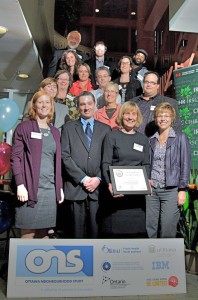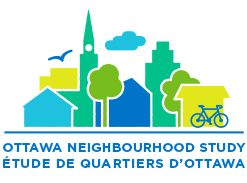About The Project
This project was originally a CIHR funded study (#79238) titled  “Tools to investigate the relationship between spatial disparities and their relationship to health disparities”. Subsequently a pilot project was designed to better define Ottawa neighbourhoods and measure and map neighbourhood social determinants of health amenable to policy interventions. The project began with neighbourhood definition, done in an iterative fashion, combining the physical boundaries and functional approaches, real estate maps, community team member knowledge, and city planning department knowledge. Contextual and compositional indicators of social determinants of health have been obtained from the Canadian Census, DMTI Enhanced Points of Interest, the City of Ottawa, and the National Capital Commission; co-investigators from Ottawa Public Health assembled a set of health indicators. All indicators have been grouped by neighbourhood. We have developed a unique and effective knowledge transfer tool; the neighbourhood profile.
“Tools to investigate the relationship between spatial disparities and their relationship to health disparities”. Subsequently a pilot project was designed to better define Ottawa neighbourhoods and measure and map neighbourhood social determinants of health amenable to policy interventions. The project began with neighbourhood definition, done in an iterative fashion, combining the physical boundaries and functional approaches, real estate maps, community team member knowledge, and city planning department knowledge. Contextual and compositional indicators of social determinants of health have been obtained from the Canadian Census, DMTI Enhanced Points of Interest, the City of Ottawa, and the National Capital Commission; co-investigators from Ottawa Public Health assembled a set of health indicators. All indicators have been grouped by neighbourhood. We have developed a unique and effective knowledge transfer tool; the neighbourhood profile.
Our work has been extremely well received; we have already shared knowledge through presentations at local, national and international conferences, community meetings and via this website, which features the neighbourhood profiles, maps, and other ways to visualize the neighbourhood data. Additional community funding has allowed us to refine our neighbourhood definitions (103 neighbourhoods in Ottawa), regularly update our data and add many new indicators of community health, and develop the neighbourhood profiles. We now have a very comprehensive data set on area exposures and health outcomes. We have undertaken multilevel analyses linking theoretically plausible indicators to specific health outcomes.
The study is important in the context of the international literature. Contextual research is increasingly relevant in population health as evidence mounts that the neighbourhoods and communities in which we live, work and raise our families has important impacts on our physical, mental, and social health. Multilevel studies have found that residence in economically disadvantaged neighbourhoods is related to mortality, poor self-rated health, cardiovascular disease/risk factors, low birth weight, and child development issues. However, reviews of the literature have noted shortcomings with many extant studies, including lack of theory, lack of precision in measuring context (most studies use limited and non-specific indicators such as area socio-economic status), use of census tracts rather than natural neighbourhoods, and lack of appropriate analyses.
The Ottawa Neighbourhood Study has overcome many of these limitations . We have gone beyond the use of census tracts in our neighbourhood definition. Our comprehensive set of indicators was selected based on their theoretical or empirical relationship to health outcomes; they provide a great deal of specificity in describing neighbourhood exposures. Finally, our analyses call for further research that will conceptualize, operationalize and measure relationships between specific health outcomes and specific area exposure. We anticipate that the peer reviewed publications that result from this study will be important contributions to the international literature on place and health.
Strength of the evidence supporting reliability and validity.
Neighbourhood definition and indicator selection are theoretically based and have been carefully done. Contextual data from commercial sources has been independently verified using web research, telephone calls, and visits to the area.Our age and sex standardized neighbourhood socio-economic index has an internal consistency of 0.89.
Health data has been assembled by epidemiologists at Ottawa Public Health from highly reliable and validated municipal and federal surveys and administrative health records, and we have taken appropriate precautions when reporting this data, especially when confidence intervals are wide.
To ensure analytic precision, we have undertaken multi-level analyses in collaboration with a methodologist at Statistics Canada.
The degree of generalizability of the research results.
The neighbourhood profiles and all results are generalizable to the greater Ottawa area, which is the primary focus for our knowledge translation.The findings on the socio-economic distribution of resources for health, and of our multilevel analyses are important to literature on place and health and point the way to interventions to improve both the social determinants of health and health within Canada and elsewhere.
Our partnership, our methods, and our findings serve as a model and a stimulus for other municipalities and university researchers. Epidemiologists in other municipalities in Ontario are now doing similar work.
We are actively working with the Renfrew County Healthy Communities Partnership to develop the Renfrew Counties Community Study.
The magnitude of the potential impact.
ONS has demonstrated success in knowledge exchange. We have either led or contributed to an explosion of interest in neighbourhood and health in Ottawa. The profiles are extremely relevant and useful as they focus on the social determinants of health and highlight neighbourhood strengths and needs. For example,
The Ottawa Public Library Ottawa Room often refers students and other researchers to this websiteas a trusted resource.United Way Ottawa has used our work to help drive its neighbourhoods agenda; to determine where to invest and support community building efforts, and to measure the impact of those investments.
ONS data and the neighbourhood profiles are used by Ottawa’s Community Health and Resource Centres (CHRCs) and by Champlain LHIN for strategic planning, health planning (gaps in service relative to need), community engagement, and proposal development. CHRCs also developed and adopted a community action strategy (see a video about No Community Left Behind) to mobilize residents to develop innovative solutions to issues they identified; the changes realized include new playgrounds, reduced gang activity, safer streets, and new or revitalized community associations.
The demonstrated successes of No Community Left Behind initiatives moved the City of Ottawa to create a policy framework to support focused neighbourhood activity (the Community Development Framework) which impacts directly on the social determinants of health and on health and social service delivery.
Our neighbourhood definitions have been adopted by the City of Ottawa to further support the development and implementation of the Neighbourhood Connections program.
We have worked with Ottawa Public Health to share knowledge about “food deserts” – neighbourhoods that lack ready access to healthy food sources; about “walkability” and “bikeability” – neighbourhoods that support safe environments for pedestrians and cyclists.
ONS has provided data and other planning support to Synapcity.
Ottawa Carleton District School Board referenced ONS to identify which neighbourhoods would most benefit from the incremental implementation of the full-day kindergarten program.
